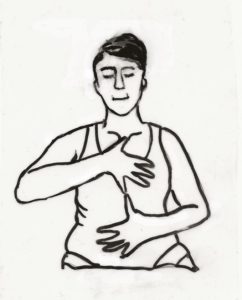In the two and a half decades that I’ve been practicing yoga, I’ve heard the term “heart centre” many times. I would place my hand above my left breast, eyes closed, assuming I’ve followed the instructions of the yoga teacher. But, even the most experienced teachers can learn something new by going back to the basics. Last month, I attended an online Pranayama workshop with the founders of Svastha Yoga Therapy, A.G. and Indra Mohan. They went over in detail the history and practice of two basic yoga breathing exercises – Lahari and Nadi Shodhana. With both of them, Indra asked us to focus on our heart centre. Noticing the way it expands with the inhale, and noticing how it relaxes and softens on the exhale.
Where do you think your heart centre is?
After the workshop, I did a little exercise in my own yoga classes to see if others had the same sense of where their heart centre is. I asked the participants to close their eyes and place a hand on their heart centre. They all put their hands on a different part of their torso – some higher up near the collarbones and others lower down near the belly. Everyone had a unique idea of where it was!
Lahari Pranayama
Lahari means ‘wave’ in Sanskrit. To practice this breath, there is no special physical technique. Just breathe naturally and smoothly, you don’t need to force the breath to deepen. If you practice this breath for awhile, you may notice that your breathing will naturally deepen and slow down as you relax and feel more calm. It is called the ‘wave’ breath is because on the surface of the water there are fluctuations as the waves roll back and forth to the shore, but underneath the surface layer it is calm. The focus on the heart centre allows you to smooth out those fluctuations and find calmness.
Nadi Shodhana
This Pranayama allows you to clear out the Ida and Pingala nadis (two of the main energy lines running up and down the central core of the body). Each nostril is connected to one of these lines. With the right hand, fold the index and middle fingers to the palm of the hand, so that there is comfortable space for the nose. Tilt the head down to make it comfortable for your shoulder and elbow. Pranayama should be easy, not forced. The right thumb first closes the right nostril, and the 4th finger half closes the left nostril to guide the breath in smoothly. A slight retention of breath helps the mind to find ease and calm. And then the thumb half opens the right nostril to guide the exhale out. Repeat on the 2nd side and continue as long as feels right for you, focusing on the heart centre.

Where is the heart centre?
Why is the heart centre important?
The heart centre is called Hridaya in Sanskrit. It is at the centre of our being, the core of connection to ourselves. It is where the physical body connects to the breath, and through where the Prana (energy lines) converge and flow. Often, it is mistakenly assumed that the heart chakra (Anahata) is where the heart centre is. But Hridaya is not located at any chakra. To find it place a thumb of one hand between your collar bones and the little finger of the other hand in your navel, spread both fingers wide, and where the other thumb and little finger meet is your heart centre.
At English Yoga Berlin we offer small classes for more personalised practice and private yoga sessions. Juli‘s yoga classes in English are a slow Vinyasa yoga / Svastha yoga mix. Contact us here to learn more or check our class schedule to participate in a group class at our Kreuzberg yoga studio or participate in one of our yoga classes live online.







